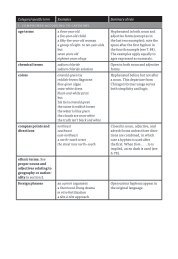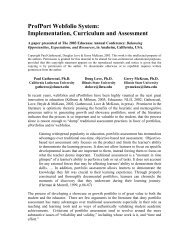Baylor University Facts
Baylor University - Educause
Baylor University - Educause
- No tags were found...
Create successful ePaper yourself
Turn your PDF publications into a flip-book with our unique Google optimized e-Paper software.
<strong>Baylor</strong> <strong>University</strong> <strong>Facts</strong>• Chartered in 1845 by the Republic of Texas• Affiliated with the Baptist General Convention of Texas• The oldest institution of higher learning in the state• Largest private university in Texas• Student population of 14,500 enrolled in• 163 baccalaureate programs• 23 master’s degree programs, 65 programs of study• One educational specialist degree• 15 doctoral degrees in the Graduate School• The Law School• Juris doctor• George W. Truett Theological Seminary• Master of Divinity/Master of Music• Doctor of Ministry• 600 + acre campus located on the banks of the Brazos River in Waco,Texas• Ranked 82 among all institutions by 2003 NACUBO Market Value ofEndowment study• Ranked in Tier 2 of 2003 U.S. News and World Report (position 78)• National <strong>University</strong> - Doctoral
Complicating Factors• The <strong>University</strong> Environment• A collection of entrepreneurs• 1870 Individuals• President• 9 Executive Council members• Seven Divisions• Academic,• Finance & Administration,• HR & Enrollment Management,• Student Life,• <strong>University</strong> Relations,• Development,• Athletics• 72 other executive level members• 730 faculty• 1060 staff
Strategic Planning at <strong>Baylor</strong> <strong>University</strong> –our recent history• June, 1995• Robert B. Sloan assumed the President’s position• <strong>University</strong> Planning Council (UPC) established• January, 1999• First structured SWOT analysis with the Executive Council• Fall, 2000• The Office of Strategic Planning established• Strategic Planning Process (SPP) adopted• Traditional, painful process• 3”, Three-Ringed Binders• Comprehensive, but not valued as a set of working documents• The Plan should always be open; not on a shelf!• Fall, 2001• The Board of Regents approved• <strong>Baylor</strong> 2012 Ten-Year Vision(that included a 40% increase in tuition)• Flat tuition structure• New university-wide financial structure• First debt offering in our history• May, 2002• The Office of Strategic Planning and Improvement established
<strong>Baylor</strong> <strong>University</strong>• Mission Statement• “The mission of <strong>Baylor</strong> <strong>University</strong> is to educate men andwomen for worldwide leadership and service by integratingacademic excellence and Christian commitment within acaring community. “• Vision Statement• “Within the course of a decade, <strong>Baylor</strong> intends to enter thetop tier of American universities while reaffirming anddeepening its distinctive Christian mission.”
The Twelve <strong>Baylor</strong> 2012 Vision Imperatives:Our Thinking About Being Competitively Successful• Establish an environment where learning can flourish• Create a truly residential campus• Develop a world-class faculty• Attract and support a top-tier student body• Initiate outstanding new academic programs in selected areas• Guide all <strong>Baylor</strong> students, through academic and student lifeprogramming, to understand life as a stewardship and work as a vocation• Provide outstanding academic facilities• Construct useful and aesthetically pleasing physical spaces• Enhance involvement of the entire <strong>Baylor</strong> family• Build with integrity a winning athletic tradition in all sports• Emphasize global education• Achieve a $2 billion endowment
Our Decision Environment• Defined by “Predicaments”• The Revenue Increase (Good Times)• “Think What We Can Do With The Money!”• The Personal Approval Method• Our success was measured in terms of increasing projectvisibility (we have identified $90M in projects)• The Expanding but Tight Budget (Not as Good Times)• “In Order to Expand Everyone Must Reduce Their Budget!”• The Opportunity/Necessity Approval Method• The “Hypothetical Factual” experience• Our success is measured in terms of blocking projects frombeing approved (we have saved $80M of mis-investment)• Largely, shaping policy is damage control – stopping whatshould not be allowed to occur!
The SideWalk Approval Process• The President walks across campus• Someone tells him of their aspirations• He encourages them with “Sounds like a good idea”• Ideas are not solutions• Several months later• The VP Finance & Administration requests the President’ssignature on a proposal• The President asks, “Where did this come from?”• The VP responds, “You communicated to this individualthat this was something we should move forward. Theyacted upon your verbal approval.”
A “Hypothetical Factual” Example• The “Situation”• A request to accept (approve) a grant was received• The grant was previously applied for through ourProvost’s Grant office (working independently)• In order to receive the grant funding, the grant had tobe signed by its deadline – which was 24 hours fromthe time that the signature request was made.• The Approval Process• The Provost’s Office forwarded the grant documentto our Office of Legal Counsel• The Legal Counsel began its review
The Review Continues• The Grant was to provide start up costs for a medicalclinic and had a three year duration• Legal Counsel identified the following:
Involved Real Property and InsuranceLegalFinance &Admin.StudentLifeHRDevelopmentProvost<strong>University</strong>RelationsPresident
Involved Collecting PaymentsLegalFinance &Admin.StudentLifeHRDevelopmentProvost<strong>University</strong>RelationsPresident
Involved Competing with ExistingProviders – thereby jeopardizing our tax-exempt statusLegalFinance &Admin.StudentLifeHRDevelopmentProvost<strong>University</strong>RelationsPresident
Required a teaching component –we needed students and facultyLegalFinance &Admin.StudentLifeHRDevelopmentProvost<strong>University</strong>RelationsPresident
It had a limited three year funding life –we would have to continue fundingLegalFinance &Admin.StudentLifeHRDevelopmentProvost<strong>University</strong>RelationsPresident
Our ChallengeHerding Cats
The BIG Challenge• To Reform Management• To Keep all the Good portions of the Sidewalk ApprovalProcess while eliminating all of the bad portions
The Office of Strategic Planning andImprovement• Our purpose• To provide the necessary process to support theimplementation of <strong>Baylor</strong> <strong>University</strong>’s defined strategy.• Since strategic choices are almost certainly surrounded withimperfect and incomplete knowledge, our planning systemmust include a continuous improvement perspective.• Our goal• To develop and implement a simple and effective iterativeplanning, budgeting, implementation and evaluationapproach to ensure that our actions are aligned with, andpromote the achievement of, our Vision 2012 imperatives.STRATEGICAlignmentTACTICAL
A Possible Assistant:Project Portfolio ManagementProject Portfolio Management (PPM) is the continuousprocess of tracking and prioritizing the optimum set of projectorientedinitiatives that deliver maximum organizational value.In this decision making process, executives can efficientlyuse their resources to focus on projects that are achievableand strategically aligned with organizational goals.The resulting project portfolio delivers a balance of what ispossible and what is needed.Slide courtesy of Pacific Edge Software, used with permission.
Using the Project Portfolio ManagementApproachBecause no single project will accomplish all of thetwelve imperatives of <strong>Baylor</strong> 2012, our ten-year vision.
The IT Implementation DatabaseThe initial use of a PPM software applicationat <strong>Baylor</strong> <strong>University</strong>
The IT Implementation Database – Profile View
The Strategic Planning ModelCombining a well-defined purpose with theinsights of stakeholders
A Strategic Planning and Improvement ModelPlanning – Proposal PhaseAcceptance-Budgeting PhasePhase 1Senior Management analyzestrends and environmental factorsand reviews proposed initiativesfor strategic fit with Vision 2012ImperativesPhase 2Strategic Planning:MissionOperating PrinciplesVisionOperational Planning:Actions PlansProcess Improvement PlansPrioritizationBudgetingSituational AnalysisStrategic DirectionsMeasurable Goals and ScoringREVIEWVision 2012Senior and Middle Management agreeon the priorities and coherence of theinitiatives and action plans. Resourcesare allocated.Deployment:Action Plan ImplementationImplementation PhasePhase 3Operational Tracking andMonitoring:Monitor Institutional PerformanceMetrics, Periodic Review, andReport AccomplishmentsMeasurement -Evaluation PhasePhase 4Senior and MiddleManagement track, reviewand evaluate outcomes andidentify performance gaps.Project Office Gating Project Office TrackingREALIZATIONProject Office TrackingProject Office Phased GatingSenior and MiddleManagement implementaction plans.
The Current Approval ModelFirst Pass2 nd through Nth PassREQUESTERECMEMBERDiscussionsHR,Compensationand Benefits,Operations &FacilitiesREVIEWSEC ScoringBUDGETREECMEMBERDECISIONConditionalApprovalComments andrequested changesApprovedRejectedVDecision of“Legitimacy”IEWDecision to seekapproval / funding
The Strategic Planning DatabasePlanning and Executing based on aProject Portfolio Management Model
The Basic Structure (approximately 150 proposals)
Project Office – Portfolio View
An Initiative Example
The <strong>Baylor</strong> 2012 Imperatives
U.S. News and World Report Measures
The <strong>Baylor</strong> Executive Council Perspective
The <strong>Baylor</strong> 2012 Budget Template
Goals, Times, Performance Measures
Goals, Times, Performance Measures
Goals, Times, Performance Measures
Goals, Times, Performance Measures
Report Selection
The President’s Summary – Page 1 (original)
The President’s Summary – Page 1 (recent)
The President’s Summary – Page 2
Report Selection Criteria
Portfolio Profile – Based on Selection Criteria
Portfolio Profile – Based on Selection Criteria
Initiative Profile – Page 1
Initiative Profile – Page 2
Executive Council Bubble Chart
The Implementation DatabaseAligning our tactics with our purpose
Tactical Planning Spans Five Divisions(out of seven: HR, Finance, Academic, Student Life, <strong>University</strong> Relations)
Information Management (ITS)
Financial Services
The Future
Decision-MakingDecentralization/Centralization• Decentralization• Changing Authority• Creating Decision Teams• Granting Signature Authority to lower levels of theorganization• The Policy Task Force• Centralization• Personnel requests• Capital Projects requests• Budget Change requests• Integration with existing data systems
Contact InformationDr. Van GrayAssociate Vice President for Strategic PlanningVan_Gray@baylor.eduNathan AtkinsonPortfolio Management AnalystNathan_Atkinson@<strong>Baylor</strong>.eduStephanie KilgoreStrategic AnalystStephanie_Kilgore@baylor.eduOffice of Strategic Planning and Improvement<strong>Baylor</strong> <strong>University</strong>254-710-8460www.baylor.edu







